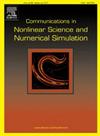Emergence and robustness of solitary states and cluster states in prey–predator model
IF 3.4
2区 数学
Q1 MATHEMATICS, APPLIED
Communications in Nonlinear Science and Numerical Simulation
Pub Date : 2025-07-09
DOI:10.1016/j.cnsns.2025.109077
引用次数: 0
Abstract
We investigate the possible scenarios for the emergence and robustness of solitary states (SS) in an identically coupled Rosenzweig–MacArthur (RM) prey–predator model, where the coupling is limited to the predator. In SS, a small subset of patches splits off and behaves differently from other patches. We also explored cluster state (CS) and synchronized oscillatory state (SOS) in an identically coupled Rosenzweig–MacArthur (RM) prey–predator model. In CS, the patches split into groups, with high (exhibits periodic oscillations) and zero prey density. In contrast, the predator population has a low density and shows periodic oscillations. Additionally, we have analyzed two distinct types of solitary states (SS1 and SS2) and evaluated the basins of attraction and probability of attaining different dynamical states using basin stability measures. Moreover, we demonstrate the emergence of two inhomogeneous steady states (IHSS), namely solitary death (SD) and cluster death (CLD), alongside solitary and cluster states. Further, we show the transition of SS1 to SD and CS to CLD state with varying the number of patches. In addition, we show the robustness and critical value of the dispersal rate required for the occurrence of SS, CS, SD, and CLD states with varying network size. Finally, we also observed that CS and CLD states were obtained in different ratios, including high and zero prey density patches. Our analysis also reveals that CS is a prerequisite for the emergence of a solitary state. We have also determined the stability conditions for solitary and cluster states.
捕食-捕食模型中孤立状态和集群状态的涌现和鲁棒性
本文研究了在相同耦合的Rosenzweig-MacArthur (RM)捕食者-捕食者模型中孤立状态(SS)出现和鲁棒性的可能情况,其中耦合仅限于捕食者。在SS中,一小部分补丁会分裂,其行为与其他补丁不同。在相同耦合的Rosenzweig-MacArthur (RM)猎物-捕食者模型中,研究了集群状态(CS)和同步振荡状态(SOS)。在CS中,斑块分成了高(表现出周期性振荡)和零猎物密度的组。相比之下,捕食者种群密度低,并呈现周期性振荡。此外,我们还分析了两种不同类型的孤立状态(SS1和SS2),并利用盆地稳定性指标评估了盆地的吸引力和达到不同动态状态的概率。此外,我们证明了两种非均匀稳态(IHSS)的出现,即孤立死亡(SD)和集群死亡(CLD),以及孤立和集群状态。此外,我们还展示了随着补丁数量的变化,SS1状态向SD状态和CS状态向CLD状态的转变。此外,我们还展示了不同网络规模下发生SS、CS、SD和CLD状态所需的分散率的鲁棒性和临界值。最后,我们还观察到不同比例的猎物密度斑块,包括高密度斑块和零密度斑块的CS和CLD状态。我们的分析还表明,CS是孤独状态出现的先决条件。我们还确定了孤立态和簇态的稳定条件。
本文章由计算机程序翻译,如有差异,请以英文原文为准。
求助全文
约1分钟内获得全文
求助全文
来源期刊

Communications in Nonlinear Science and Numerical Simulation
MATHEMATICS, APPLIED-MATHEMATICS, INTERDISCIPLINARY APPLICATIONS
CiteScore
6.80
自引率
7.70%
发文量
378
审稿时长
78 days
期刊介绍:
The journal publishes original research findings on experimental observation, mathematical modeling, theoretical analysis and numerical simulation, for more accurate description, better prediction or novel application, of nonlinear phenomena in science and engineering. It offers a venue for researchers to make rapid exchange of ideas and techniques in nonlinear science and complexity.
The submission of manuscripts with cross-disciplinary approaches in nonlinear science and complexity is particularly encouraged.
Topics of interest:
Nonlinear differential or delay equations, Lie group analysis and asymptotic methods, Discontinuous systems, Fractals, Fractional calculus and dynamics, Nonlinear effects in quantum mechanics, Nonlinear stochastic processes, Experimental nonlinear science, Time-series and signal analysis, Computational methods and simulations in nonlinear science and engineering, Control of dynamical systems, Synchronization, Lyapunov analysis, High-dimensional chaos and turbulence, Chaos in Hamiltonian systems, Integrable systems and solitons, Collective behavior in many-body systems, Biological physics and networks, Nonlinear mechanical systems, Complex systems and complexity.
No length limitation for contributions is set, but only concisely written manuscripts are published. Brief papers are published on the basis of Rapid Communications. Discussions of previously published papers are welcome.
 求助内容:
求助内容: 应助结果提醒方式:
应助结果提醒方式:


